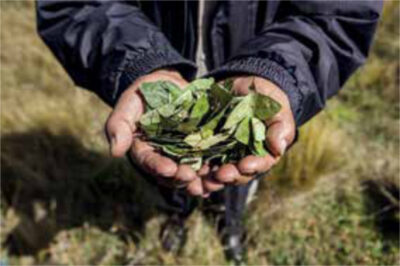Main content
Since ancient times, many types of (psychoactive) substances have been used by mankind. Of course, some of these substances, like tobacco, cannabis and cocaine, have become well-known globally, and there is an increasing body of knowledge about their use and health effects. However, there are also many psychoactive substances which are far less known and whose use is more confined to specific cultural or religious groups. In this article, we highlight some of these substances and their (adverse) effects on health.
Betel nut
Betel nut, or areca nut, is the seed of the fruit of the areca palm which grows in the tropical Pacific, Southeast Asia and South Asia, and parts of east Africa. In these areas, betel nut chewing is a common cultural practice. There is evidence that betel nut usage is increasing.[1] It is estimated that more than 10% of the world’s population consumes betel nut in some form.[2] Betel nut is most commonly used by slicing it into thin pieces and rolling it in a betel leaf with slaked lime, hereby forming a package known as a betel quid or betel paan.[3] Over the years, an increase has been seen in the addition of tobacco to the betel quid, which further increases the health risks of individuals using it.[1]

The effects of betel nut are caused by the alkaloids inside the areca nut, of which arecoline is the most important one.[4] Arecoline has several effects on the central nervous system. It causes an increase in sympathetic activity, thereby increasing adrenaline and noradrenaline levels. This leads to tachycardia, increase of skin temperature, and reduction in hunger. It also stimulates the parasympathetic system, causing euphoria and enhanced alertness.[4] Habitual betel nut usage can cause a variety of adverse health outcomes, of which induction of oral precancerous lesions is the most important one. Depending on the type of lesion, these can turn malignant over several years to decades. Betel nut has been classified as a Group 1 carcinogen by the International Agency for Cancer Research (IACR).[1] Other described health effects are periodontal disease, oral submucous fibrosis (a chronic lesion of the oral cavity), decreased fertility, enlarged prostate, elevated risk of other chronic diseases such as cardiovascular diseases, diabetes mellitus and chronic kidney disease, and increased risk of developing other malignancies such as liver cancer and breast cancer.[4] In 2012, the World Health Organization (WHO) published a report which highlighted the need for effective measures to discourage the use of betel nut, including policies, education and clinical services.[1] Unfortunately, until now, little information is available on evaluations of educational strategies aimed at reducing betel nut use.[4]
Khat
Khat, also called qat, kaht and several other similar names, is a plant (Catha edulis) of which the buds and leaves are chewed for their stimulant effects. Its use is embedded in cultural and social traditions in parts of Eastern Africa, such as Somalia and Ethiopia, and in parts of the Middle East, such as Saudi Arabia and Yemen.[5] The psychoactive effects of khat are caused by the active substances cathinone and cathine, which are amphetamine analogues.[6] They cause feelings of happiness, and increase alertness, energy and self-esteem. Unfortunately, long-term use of khat can cause a large variety of adverse health effects, as shown by a recent review of Alshoabi et al.[7] Within the cardiovascular system, it can cause increased blood pressure and an increased risk of myocardial infarction. Described adverse effects on the digestive system are, among others, dental caries, gastritis, risk of hepatoxicity and gastrointestinal tract cancers. Within the nervous system, khat may cause insomnia, hallucinations and stress, and it increases the risk of stroke.
Most countries do not have a clear policy with regard to khat use. There are several international initiatives in the field of khat research, of which the National Institutes of Health (NIH) funded Khat Research Program is the largest. The goal is to gain knowledge in order to develop evidence-based harm-reduction, prevention, and treatment strategies.[8]
Coca leaves
Coca (Erythroxylum coca) is an indigenous plant of western South America. For thousands of years, the leaves of this plant have been of great importance in the lives of native Andean people, who use the leaves (either by chewing or making tea) for cultural and religious motives. Chewing coca together is of great importance in acknowledging and supporting social relationships.[8] But the leaves are also used for medicinal purposes. Historically, and still today, coca has been and is used to support physical labour, as it has a stimulating effect and reduces fatigue and appetite. It also works as a local anaesthetic, reduces gastrointestinal complaints when ingested as tea, and helps against high-altitude sickness.[9]

The coca plant contains several alkaloids, of which the psychoactive component cocaine is the principal and best known one.[10] Most of the research has been done on cocaine and not on the other alkaloids, which has led to a scarcity of scientific knowledge about the effects of whole coca leaves. A recent case report from Molina-Àvila (2022) presented four cases of patients, known coca leaves chewers, developing oral squamous cell carcinoma (OSCC) in the absence of the typical known risk factors for OSCC like smoking, excessive alcohol consumption, areca and betelnut, HPV or chronic mechanical irritation.[11] The authors state that this could indicate a pathophysiological relationship between chronically chewing coca leaves and developing OSCC, but further studies are needed to establish this. As mentioned above, studies on the adverse effects of coca leaves are scarce and controversial. Until now, no genetic damage within the oral mucosa caused by coca has been found, contrary to what is known about the betel nut ingredients.[12] Dental and periodontal lesions have been described as a result, and the lesions themselves could lead to oral carcinogenesis.
Methanol
Although possibly less linked to a specific culture, methanol should not be absent from this article, as methanol abuse and poisoning is an issue within various cultural groups globally. Methanol is a toxic alcohol that is legally used industrially as a solvent, pesticide, and alternative fuel source. This toxic alcohol is sometimes also used as a cheaper alternative for ethanol (consumable alcohol). When ingested by humans, it can cause methanol poisoning with fatal consequences. Industrial methanol is either added to legal alcoholic beverages, or is derived from inappropriate home brewing of alcohol. Both these types of ‘illegitimate alcohol drinks’ are consumed within several cultures and countries. The highest consumption is in Europe, followed by South America and Africa.[13] Home-brew beverages with methanol are often the result of financial motives, but homebrews can also be more culturally embedded with unintended methanol content, for example in the case of local medicinal herbal drinks.
A study by Nili-Ahmadabadi et al. (2016), analysing medicinal herbal drinks marketed in Hamadan, Iran, found that 50% of the drinks were contaminated with methanol. Outbreaks of acute methanol poisoning have been reported worldwide. One example is an outbreak in Uganda in 2017, caused by drinking adulterated ‘Waragi’ (a Ugandan gin), with a very high case fatality rate of 80%.[14] Methanol is rapidly absorbed after oral ingestion and is metabolized by alcohol dehydrogenase enzyme (ADH) to toxic metabolites. These metabolites cause retinal damage and necrosis of basal ganglia, which can lead to irreversible neurologic damage and death.[15] Besides general emergency management, treatment involves ADH inhibition therapy with, for example, ethanol. Ethanol has a higher affinity for ADH then methanol, thereby blocking the metabolism of methanol to the toxic metabolites.
Unregistered alcohol is produced without supervision or regulations, resulting in a lack in quality control and safety. At a policy level, the formulation of mitigation strategies to address this public health issue is challenging. Policymakers need to target measures in different areas, including access to alcohol, financial motives, knowledge and information, culture, community norms, and behaviour.[16]
Conclusion
Globally, there is a great variety of substances which are being used and/or abused within different cultures and communities. Unfortunately, many of these substances can have adverse health outcomes. When working as a doctor in an unfamiliar setting, it can be useful to gain knowledge about local cultural and traditional substance use. On a policy level, addressing the use of these culture-related substances comes with challenges. First of all, there is a lack of evidence-based research on health effects. Second, many of these substances are deeply embedded in a culture, and policymakers need to take this into account when devising policy measures.
References
- World Health Organization. Review of areca (betel) nut and tobacco use in the Pacific: a technical report.; 2012.
- Gupta, P.C. & Warnakulasuriya, S. 2002. ‘Global epidemiology of areca nut usage’, Addiction Biology, Vol. 7, No.1. pp.77 – 84
- Alcohol and Drug Foundation. Betel nut. Available from: https://adf.org.au/drug-facts/betel-nut/ [Accessed 27th of May 2022]
- Joo YJ, Newcombe D, Nosa V, et al. Investigating Betel Nut Use, Antecedents and Consequences: A Review of Literature. Substance Use & Misuse. DOI: 10.1080/10826084.2019.1666144
- Jerah A, Bidwai A, Alam M. A review of the history, cultivation, chemistry, pharmacology and adverse health effects of khat. International Journal of Applied and Natural Sciences. 2017;6(3):2319-4022.
- Silva B, Soares J, Rocha-Pereira C, et al. Khat, a Cultural Chewing Drug: A Toxicokinetic and Toxicodynamic Summary. Toxins 2022. 14, 71. https://doi.org/10.3390/toxins14020071
- Alshoabi SA, Hamid AM, Gameraddin MB. Risks of khat chewing on the cardiovascular, nervous, gastrointestinal, and genitourinary systems: a narrative review. Journal of Family Medicine and Primary Care. 2022 Jan;11(1):32-36
- Odenwald M, al’Absi M. Khat use and related addiction, mental health and physical disorders: the need to address a growing risk. Eastern Mediterranean Health Journal. 2017 May 1;23(3):236-244.
- Bauer I. Travel medicine, coca and cocaine: demystifying and rehabilitating Erythroxylum – a comprehensive review. Tropical diseases, Travel Medicine and Vaccines. 2019;5:20.
- Biondich AS, Joslin JD. Coca: The History and Medical Significane of an Ancient Andean Tradition. Emergency Medicine International. 2016;2016:40487
- Molina-Ávila I, Rojas AA, Gilligan G, Cordero-Torres K.Oral squamous cell carcinoma in coca chewers from a north region of Argentina: A case series and review of literature. Journal of Oral and Maxillofacial Pathology. 2022;26:S124-8.
- Nersesyan A, Kundi M, Krupitza G, Barcelos G, Mišík M, Wultsch G, et al. Induction of nuclear anomalies in exfoliated buccal cells of coca chewers: Results of a field study. Arch Toxicol 2013;87:529-34.
- Nekoukar Z, Zakariaei Z, Taghizadeh F, et al. Methanol poisoning as a new world challenge. Annals of Medicine and Surgery 66. 2021;102445.
- Doreen B, Eyu P, Okethwangu D, et al. Fatal methanol poisoning caused by drinking adulterated locally distilled alcohol: Wakiso District, Uganda, June 2017. Journal of Environmental and Public Health. 2020;5816162.
- Sivilotti MLA. Methanol and ethylene glycol poisoning: Pharmacology, clinical manifestations, and diagnosis. In: UpToDate. [Accessed 20th June 2022]
- Manning L, Kowalska A. Illicit alcohol: public health risk of methanol poisoning and policy mitigation strategies. Foods. 2021;10;1625.



















































